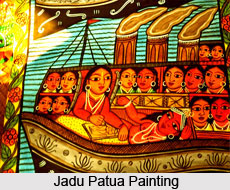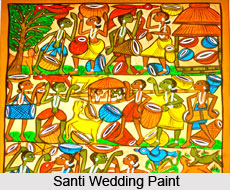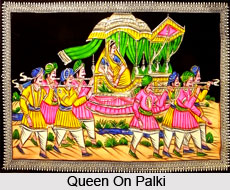 The Jadupatua paintings are vertical scroll paintings that were performed on cloth in earlier days but later these paintings were done on papers. These painting were popular in Murshidabad, Birbhum, Bankura, Hooghly, Burdwan, and Midnapore districts of West Bengal and Santal Parganas of Bihar. From the olden times, the scroll paintings or the pata has been popular in various parts of India.
The Jadupatua paintings are vertical scroll paintings that were performed on cloth in earlier days but later these paintings were done on papers. These painting were popular in Murshidabad, Birbhum, Bankura, Hooghly, Burdwan, and Midnapore districts of West Bengal and Santal Parganas of Bihar. From the olden times, the scroll paintings or the pata has been popular in various parts of India.
The scrolls were made from waste paper, which had been discarded by shops or by government offices because good paper was not easily available. The scrolls were made up of sheets of paper that were either glued together or sewn together and a piece of old cloth or calico was sewn to the end of the scroll to protect the paper from damaging. The two ends of the cloth were sewn round pieces of bamboo, one of which acted as a roller around which the scroll could be wound. Finally a string was attached to one end to secure the wound-up scroll. Some scrolls were short and consisted of only two or three panels; others could contain fourteen or more. In the present collection one scroll has been kept intact and the remainder cut into sections and were separately mounted.
The scroll paintings were prepared mainly for Santal audiences by a special Hindu painter caste known as jadupatuas and were collected in the Santal Parganas.
The brushes used by jadupatuas were bunches of goats hair tied to a small stick or porcupine quill. Earlier the paintings were done with natural colors made from vegetable matter or minerals. By the 1940`s colors were available in the bazaars. Still the jogendra chitrakars used soot for black, vermilion for red and mud from the riverbed for a rich reddish brown, but purchased blue and yellow colors from the bazaar. Despite limited colors and materials, jadupatua scrolls in the Santal Parganas portray great varieties of expressions and treatment and on the other hand, there is a consistent adherence to certain basic assumptions. The Jadupatuas of adjoining circles were aware of each other`s family idioms and borrowed subconsciously from each other. Occasionally outside influences could also be seen reflected in the scrolls. All the jadupatua families had affinities with the patuas of Bengal and their conception of painting was determined by long-established traditions. Scrolls though appeared in minor idioms, they embodied common attitudes to form and style. All scrolls depicted figures in a single flat plane and showed a mild indifference to naturalism. The stories are depicted in a series of simple clear-cut images in panels divided by horizontal bands. Simple diagrammatic forms depict trees, flowers or rocks. The figures are depicted usually in a standard corrugated line linking forehead, nose, lips and chin and eyes were vastly enlarged.
Santal women are depicted as straight vertical figures which possess a monumental dignity and echo the graceful movements of Santal dancing. Throughout the painting there is an emphasis on horizontal and vertical lines but these are at times cut across by the bold zigzag movements of a leaping drummer or galloping horse. There was a readiness to distort any for the purpose of expression. Color is used romantically for dramatic or poetic purposes. Tigers are colored bright yellow, brown, grey or even blue or green. Their heads are over-Large; teeth, claws and tongues are magnified and touches of red contribute to an image of terrifying force and danger. There are blue elephants and red horses that symbolize an air of wealth and splendor. Women who normally wear white are shown in flaming red and their chocolate complexions changed to white or yellow color. The most obvious stylistic differences occur in scrolls from areas where contact with Hindu society is greatest(in the parts of Dumka and Jamtara bordering on Bengal) and a certain sophistication can be seen. Figures are depicted in full-face. Milkmaids are depicted with a wan and prissy slimness, with large veils billowing around their heads. Men have curling Bengali hair style and wear Bengali clothes and we see that there is a fondness for pretty colors like pink and pale blue.
Patanjali refers to such scroll paintings in his works and also in Banudatta`s work Harshacharita there is mention of entertainers or minstrels, known as yamapattakas. The yamapattakas were depicted in scroll paintings showing the rewards and the punishments meted out by Yama, the God of death to the souls after their departure from the mortal world. The artists who painted these scroll were known as Jadupatuas or Duari Patuas, which literally meant magical painters and their paintings were known as Jadupatua Paintings.
The scrolls in horizontal forms are still produced in Rajasthan while vertical scroll-painting illustrating stories in a series of descending panels were produced in Bengal. The Patuas or the village artists made the scrolls paintings in West Bengal in the districts of Murshidabad, Birbhum, Bankura, Hooghly, Burdwan and Midnapore. There were paintings on cloth illustrating scenes from the Ramayana and Bhaagvata Puarna. In the recent times, the paintings on cloth have been replaced by paintings on paper. In the 1940`s scroll paintings on paper were made in the Santal Parganas district of Bihar. The district of Santal Parganas lies in the red soil uplands adjoining West Bengal and the region is inhabited partly by Hindus and a few Muslims. But the majority of the population consists of the Santals, who are the largest and the most integrated aboriginal tribe of Bihar. The Santals spoke in the Santali (pre- Dravidian language). The scroll paintings in the India Office Library were prepared mainly for Santal audiences by a special Hindu painter caste known as jadupatuas and were collected in the Santal Parganas. The jadupatuas are members of a small community, who are compared in social status to potters, barbers, blacksmiths and sweetmeat makers. Similar to the patuas of Bengal, they lived in the Santal Parganas. They earned their livelihood by wandering from village to village singing the stories depicted and for a night`s performance, they earned about two annas or rice. They traveled carrying with them the bag of scrolls and a bamboo container of oil. At the age of 19, the jadupatuas earned their livelihood. The jadupatuas spoke in debased Bengali and could thus communicate with Santals. The Santals held the jadupatuas in admiration and for this reason the caste had come to be known in the Santal Parganas and not merely as patua. In an attempt to rise up the social ladder, the jadupatuas discarded this name and had taken to calling themselves as chitrakar (painter).
The jadupatuas in the Santa Parganas had another means of income. Whenever they heard of the news of a death of any Santal they would paint and bring out a stock of small `mortuary` pictures depicting men, women and children of all ages, except that in each case the eye lacked a pupil. Besides these paintings, there were small drawings of various objects, such as a cow, goat, chickens, brass dishes, ornaments or money. On arriving at the dead persons home the jadupatuas would enquire about the dead person and estimate the family`s resources and then he would produce a relevant picture. He would then explain to the deceased persons relatives that their dead relative is wandering blind in the other world and that his sight could be restored if he (the jadupatua) supply or paint pupils in his blind eyes. Further he tells that he would render the service only in return for the objects indicated in the picture. This magical act of bestowing sight led the Santals to call the painters as jadupatuas or magical painters. Having received his payment the jadupatuas would sit on his heels and unroll his scrolls to chant the appropriate commentary. The jadupatuas claim that by doing this they could help the mourners to escape from their grief. At last the jadupatuas depart taking his rewards with him. In certain other cases they would extract yet another fee. The charred bones of the deceased are supposed to be immersed in the sacred Damodar River, the `sea` of Santal legend. As it is far away, the Santals would pay the jadupatua to go to the Damodar and do the rites.
Seven Themes of Jadupatias
Seven themes of the scroll paintings made by jadupatuas in the Santal Parganas are :
1. Life in Death`s kingdom
2. The story of the creation of the Santals as preserved in Santal tradition
3. The Santal festival of Bahajatras
4. Mass meetings of the Santals for dancing
5. The personification of Santal clans
6. A tiger or leopard often with a human rider and
7. Finally, the adventures of Krishna with the milkmaid.



















